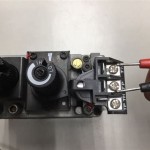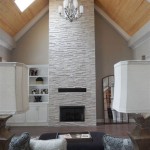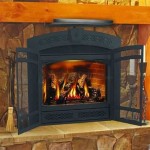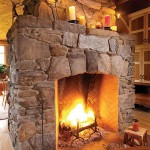The Enduring Appeal of a Fireplace in the Kitchen: Design, Functionality, and Considerations
The fireplace, traditionally a focal point of the living room or den, is increasingly finding its way into the heart of the home: the kitchen. This resurgence of interest stems from a desire to blend practicality with aesthetics, creating a warm and inviting space that transcends the purely utilitarian nature of the modern kitchen. Incorporating a fireplace into the kitchen design requires careful consideration of factors ranging from ventilation and safety to architectural style and personal preferences. This article explores the various aspects of integrating a fireplace into the kitchen, highlighting its design potential, functionality, and the key elements that contribute to a successful installation.
The allure of a kitchen fireplace extends beyond its visual appeal. Historically, the fireplace was the central element of the home, serving as the primary source of heat for cooking, warmth, and even lighting. While modern kitchens boast sophisticated appliances and efficient heating systems, the fireplace evokes a sense of connection to the past, creating a cozy and comforting environment that is both functional and emotionally resonant. This combination of practicality and nostalgia is a powerful draw for homeowners seeking to create a kitchen that is both aesthetically pleasing and deeply personal.
Design Considerations for Kitchen Fireplaces
Integrating a fireplace into the kitchen design requires meticulous planning and an understanding of the architectural possibilities. The style of the fireplace should complement the overall aesthetic of the kitchen, whether it be a rustic farmhouse, a sleek modern space, or a classic Victorian design. The size and placement of the fireplace are also crucial factors, as they can significantly impact the flow and functionality of the kitchen.
One of the primary design considerations is the type of fireplace to be installed. Traditional wood-burning fireplaces offer the charm and authenticity of a real fire, but they also require a chimney, a consistent supply of wood, and regular cleaning. Gas fireplaces provide a convenient and cleaner alternative, offering instant heat and adjustable flames with minimal maintenance. Electric fireplaces are another option, offering ease of installation and operation, but they lack the authenticity of a real flame. The choice of fireplace type will depend on individual preferences, budget, and the architectural constraints of the kitchen.
The materials used for the fireplace surround and hearth are another important design element. Stone, brick, tile, and metal are all popular choices, each offering a unique aesthetic. Stone and brick evoke a rustic and traditional feel, while tile can add a touch of elegance and sophistication. Metal surrounds can create a sleek and modern look. The hearth, the area in front of the fireplace, should be made of a non-combustible material and should be large enough to protect the surrounding floor from sparks and embers. The choice of materials should not only complement the style of the fireplace but also blend seamlessly with the overall design of the kitchen.
Furthermore, the placement of the fireplace within the kitchen layout is crucial. It can be incorporated into a feature wall, serving as a visual anchor for the space. Alternatively, it can be positioned near the dining area, creating a cozy and intimate setting for meals. In open-plan kitchens, the fireplace can act as a natural divider, separating the cooking area from the living space. The placement should be carefully considered to maximize both the aesthetic impact and the functional benefits of the fireplace.
Lighting is an often overlooked aspect of fireplace design. The warm glow of the fire can be enhanced by strategically placed lighting fixtures, such as sconces, recessed lights, or pendant lamps. Dimmer switches can be used to adjust the lighting levels, creating a cozy and inviting atmosphere. The lighting should complement the style of the fireplace and the overall design of the kitchen, enhancing its visual appeal and functionality.
Functional Aspects of a Kitchen Fireplace
Beyond its aesthetic appeal, a fireplace in the kitchen can serve several functional purposes. It can provide supplemental heat, create a cozy atmosphere for cooking and dining, and even be used for cooking food, harkening back to its historical significance.
One of the primary functions of a kitchen fireplace is to provide supplemental heat. During colder months, the fireplace can help to warm the kitchen, creating a comfortable and inviting space for cooking and gathering. This can reduce the reliance on central heating, potentially saving on energy costs. The amount of heat generated by the fireplace will depend on the type of fireplace, its size, and the efficiency of the design.
The fireplace can also enhance the cooking experience. For those who enjoy cooking with open flames, a wood-burning fireplace offers the opportunity to prepare traditional dishes using authentic methods. The smoky flavor imparted by the fire can add a unique dimension to grilled meats, vegetables, and even baked goods. While cooking over an open fire requires skill and attention, it can be a rewarding and enjoyable experience.
Moreover, a fireplace can serve as a focal point for social gatherings. The warmth and ambiance of the fire can create a cozy and inviting atmosphere for family meals, dinner parties, and casual get-togethers. The fireplace can also be incorporated into a kitchen island or breakfast bar, providing a comfortable and stylish setting for informal dining. The functional benefits of a kitchen fireplace extend beyond mere heating and cooking, contributing to a more enjoyable and communal cooking and dining experience.
Additionally, when designing the kitchen fireplace, the homeowner may consider integrating storage solutions. Wood-burning fireplaces, in particular, will require a place to store firewood. This can be accomplished with built-in shelving or with a dedicated wood box located near the fireplace. Gas fireplaces may require storage for propane tanks, if applicable. Thoughtful storage solutions can help to keep the kitchen organized and clutter-free while also adding to the aesthetic appeal of the fireplace area.
Safety and Ventilation Considerations
Safety is paramount when installing a fireplace in the kitchen. Proper ventilation is essential to ensure that smoke, fumes, and carbon monoxide are safely vented outside the home. Regular maintenance and inspections are also necessary to prevent fires and other hazards. Adhering to building codes and safety standards is crucial for a safe and functional kitchen fireplace.
Proper ventilation is essential for all types of fireplaces, but it is particularly important for wood-burning fireplaces. A chimney is required to vent smoke and fumes outside the home. The chimney should be properly sized and constructed to ensure adequate draft. Regular cleaning and inspections are necessary to prevent creosote buildup, which can be a fire hazard. Gas fireplaces also require proper ventilation to prevent the buildup of carbon monoxide. A vent pipe should be installed to direct exhaust gases outside the home. Electric fireplaces do not require ventilation, as they do not produce smoke or fumes.
Carbon monoxide detectors should be installed in the kitchen and other areas of the home to provide early warning of dangerous carbon monoxide levels. These detectors should be tested regularly to ensure that they are functioning properly. It is also important to educate all members of the household about the dangers of carbon monoxide poisoning and the symptoms to watch out for.
Fire safety is another important consideration. A fire extinguisher should be readily accessible in the kitchen in case of a fire. The fireplace area should be kept clear of flammable materials, such as curtains, rugs, and furniture. A fire screen or mesh should be used to prevent sparks and embers from escaping the fireplace. It is also important to supervise children and pets around the fireplace to prevent accidents.
Furthermore, regular maintenance and inspections are essential to ensure the safe operation of the fireplace. The chimney should be inspected annually by a qualified professional to check for cracks, leaks, and other damage. The fireplace should be cleaned regularly to remove ash, soot, and creosote. Gas fireplaces should be inspected and serviced by a qualified technician to ensure that the gas lines and burners are functioning properly. Following these safety precautions can help to prevent fires and other hazards, ensuring a safe and enjoyable kitchen fireplace experience. Adherence to local building codes and obtaining the necessary permits are also crucial steps in ensuring a safe and compliant installation.

Cosy Up Your Kitchen With A Fabulous Fireplace Houzz

9 Cozy Kitchens With Fireplaces Fireplace Kitchen

Hot Trends Give Your Kitchen A Sizzling Makeover With Fireplace Decoist

Fireplace Ideas 7 Unexpected Hearths Bob Vila

7 Reasons To Consider A Fireplace In Your Kitchen Makeover Hadley Court Interior Design Blog

How To Choose A Fireplace For Kitchen

Kitchen Fireplace Ideas Design Inspiration Ecosmart Fire

Relocate Your Family Fire Kitchen Fireplaces Blog

How To Choose A Fireplace For Kitchen

25 Fabulous Kitchens Showcasing Warm And Cozy Fireplaces Kitchen Fireplace Rustic Modern Interior








